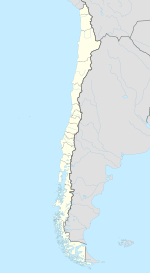Tucapel
| Tucapel | |||||
|---|---|---|---|---|---|
| Town and Commune | |||||
|
|||||
| Coordinates (town): 37°17′S 71°57′W / 37.283°S 71.950°WCoordinates: 37°17′S 71°57′W / 37.283°S 71.950°W | |||||
| Country | Chile | ||||
| Region | Bío Bío | ||||
| Province | Bío Bío | ||||
| Government | |||||
| • Type | Municipality | ||||
| • Alcalde | Jaime Sergio Veloso Jara (RN) | ||||
| Area | |||||
| • Total | 914.9 km2 (353.2 sq mi) | ||||
| Elevation | 331 m (1,086 ft) | ||||
| Population (2012 Census) | |||||
| • Total | 13,427 | ||||
| • Density | 15/km2 (38/sq mi) | ||||
| • Urban | 8,827 | ||||
| • Rural | 3,950 | ||||
| Demonym(s) | Tucapelino | ||||
| Sex | |||||
| • Men | 6,403 | ||||
| • Women | 6,374 | ||||
| Time zone | CLT (UTC-4) | ||||
| • Summer (DST) | CLST (UTC-3) | ||||
| Area code(s) | 56 + 43 | ||||
| Website | Municipality of Tucapel | ||||
Tucapel is a town and commune in the Arauco Province, Bío Bío Region, Chile. It was once a region of Araucanía named for the Tucapel River. The name of the region derived from the rehue and aillarehue of the Moluche people of the area between the Lebu and the Lleulleu Rivers, who were famed for their long resistance to the Spanish in the Arauco War. Tucapel is also the name of a famous leader from that region in the first resistance against the Spanish mentioned in Alonso de Ercilla's epic poem La Araucana. Formerly belonging to the Nuble Province, in the Department of Yungay. Near the town of Tucapel is the Plaza de San Diego de Tucapel. The capital of the commune is the town of Huépil, moving the municipality from Tucapel in 1967. In mapudungún its name means "To seize or to take by force".
The main economic activities of the commune are commerce, agriculture and forestry.
Tucapel is an old foundation in the country, originally part of the Rere Province, in which three La Frontera fortresses existed: Talcamávida, Yumbel and San Diego de Tucapel.
The fortress of San Diego de Alcalá de Tucapel was founded by Pedro de Valdivia in 1552 on a hill in the valley of the Tucapel River at the present location of the city of Cañete. Near here, the conqueror died after being surprised and defeated at the Battle of Tucapel by Lautaro, after he had arrived to relieve the fortress, which Lautaro had already destroyed before December 25, 1553.
...
Wikipedia



